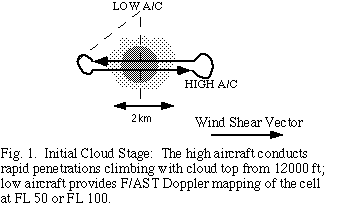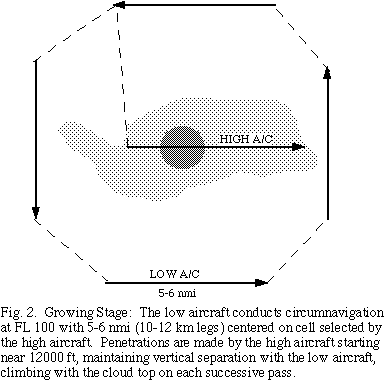Clouds and Climate Experiment
This document is divided into 3 sections:
Program Significance
Clouds and aerosol, and their interactions must be realistically considered in any significant and comprehensive study of climate change. The radiative effects of clouds play a dominant role in climate and climate change. The aerosol environment of the
clouds, besides having a direct radiative effect, have very significant interactions with the cloud radiative properties (albedo) through the cloud microphysics, and, in addition, important interactions on the resultant tropospheric heating profiles thro
ugh the precipitation formation and evolution. Adequate measurements of these important cloud effects are scarce, because they are difficult measurements to make, and much of the important area is over the vast expanses of the tropical oceans. This propo
sed study is designed to accumulate a data base of these important cloud-aerosol properties over a wide range of environments. It involves a spectrum of sampling scenarios from cloud census as targets of opportunity on non-dedicated flights, the measure
ment of the microphysical evolution of convective clouds over the cloud's life cycle, to dedicated cloud-aerosol dust sampling transects. This study emphasizes the exploitation of both in-situ and remote sensing (radar and satellite) of clouds. It will
provide a data base for the interactions of clouds and climate, and provide ground truth data for satellite data and techniques. This is an extension of previous work we have done which was aimed at understanding precipitation development in small ocean
ic cumulus clouds. We propose to extend this work to include the added objective of understanding the role that several scales of convective clouds play in the climatic system. The goal of the study is to start building a cloud-aerosol data base that has
potential uses in several facets of climatic analysis.
It has become widely recognized that the physics of clouds and precipitation must be considered in any realistic study of climate change. Clouds and water vapor play a pivotal role in the Earth's heat and radiation budgets. They control the amount of sol
ar energy absorbed by the climate system as well as the infrared radiation emitted to space, and they strongly influence the redistribution of heat throughout the climate system, particularly in the tropics. Tropical clouds and cloud systems, because they
lie in the zone of maximum solar input into the atmospheric system, have an important, and probably direct climatic effect. Together with the release of latent heat, the radiative heating of layered clouds in the upper tropical troposphere is a significa
nt source of energy for driving the global circulation. A wide spectrum of tropical cloud types and sizes are important from a climate viewpoint. In some instances, the very small scale microphysical characteristics of the clouds, and interactions with th
e cloud dynamics, are important on the climate scale.
This is an extension of previous work we have done which was aimed at understanding precipitation development in small oceanic cumulus clouds in the FOCUS and Oceanic Cumulus Experiments. The data collected in these experiments were used to study the rel
ationship between initial and subsequent precipitation formation and the interaction between precipitation loading and the dynamics of the convective cell. It was also used to study the interactions between warm cloud and ice microphysics at different sta
ges of cloud development. We propose to extend this work to include the added objective of understanding the role these small precipitating convective clouds play in the climatic system. The goal of the study is to start building a data base that has pote
ntial uses in several facets of climatic analysis.
Objectives
The objectives of the experiment are:
The experiment will document the kinematics and microphysics of
a representative sample of convection, with the initial emphasis being on small precipitating convective cells. We are particularly interested in these clouds` life cycle evolving from first condensation to a precipitating stage (glaciated or not). The s
pecific scientific objectives of this experiment include:
- Building a data base, or census, of small precipitating cumulus;e.g., dimensions (top height, diameter, and depth) and precipitation characteristics that has potential uses in several facets of climatic analysis.
- Documenting the thermodynamic and wind environment of the clouds. Mapping the three dimensional flow field within an active convective feature, and computing the hydrometeor trajectories into the region surrounding the storm using the airborne Dopple
r radar. Defining differences in mid level convergence compared to EMEX and COARE (Mapes).
- Collecting rainfall statistics of oceanic convection for use in statistical rainfall studies.
- Measuring the radiative properties of the clouds and aerosol (Flatau).
- Testing the capability of determining the hydrometeor distributions from the reflectivity and Doppler mean velocity data at, or near, vertical incidence.
- Documenting the initial electrification and the evolution of the electric field within a sample of clouds.
- Documenting the characteristics of significant convective updrafts - water mass flux, the evolution of ice particles in the updrafts and the conversion rates to ice.
- Measuring the aerosol environment of the clouds including activity spectrum of the CCN concentrations in the cloud environments, temperature classified condensation nuclei CN (Hudson and Hallett), and physical properties of the dust aerosol(Prospero).
This needs to be done in the boundary layer roots of convection and at higher entrainment levels.
- Study the relationship between initial and subsequent precipitation formation and the interaction between precipitation loading and the dynamics of the convective cell.
- Study the interactions between warm cloud and ice microphysics at different stages of cloud development. Emphasis will be placed on the warm rain development versus rain from glaciation.
Mission Description
The program will be conducted on targets of opportunity during participation in other flight experiments. In addition dedicated flights are proposed over South Florida within range of the NEXRAD radars, and in a more pristine oceanic environment in the
vicinity of Barbados. In addition a dedicated aerosol flight east of Barbados is planned, possibly as an alternative flight profile during, or as a fallback to, a genesis experiment.
Mission Description: The experiment calls for a broad spectrum of sampling strategies, but with two fundamental experimental modules: 1) The basic two aircraft cloud structure and evolution sampling module (Fig. 1 and Fig. 2), sampling targets of opport
unity for the census with altitude selection and minor deviations for cloud sampling as feasible;


and 2) A full aerosol and dust module involving dedicated dust sampling flights. All designed to contribute to at least some part of the stated objectives. Sampling along deployments will emphasize remote sensing, while more dedicated flights will invol
ve combinations of remote sensing and cloud penetrations.
There are TWO modules associated with this experiment:
Back to the Hurricane Field Program Experiment page.


